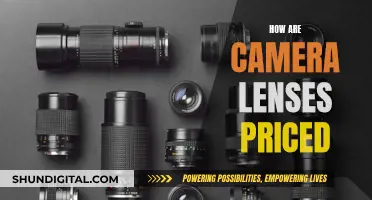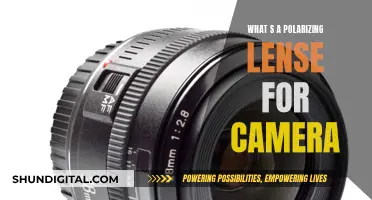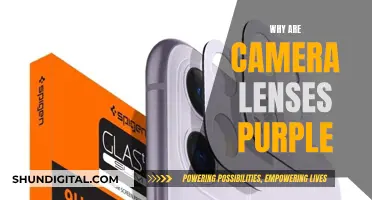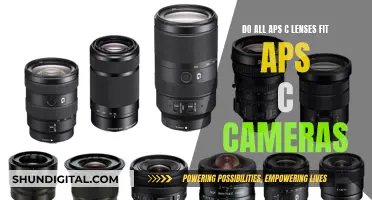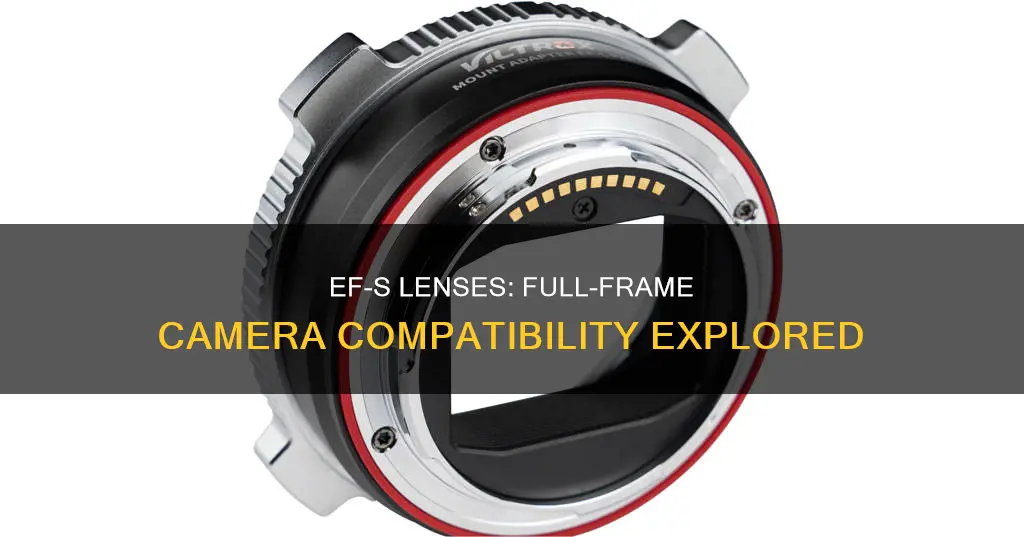
Canon EF-S lenses are not compatible with full-frame cameras. The S in EF-S stands for small image circle or short back focus, meaning that the lens projects a smaller image circle than normal EF lenses to match the sensor. This means that if you were to use an EF-S lens on a full-frame camera, you would see heavy vignetting (the corners of the image would be black) because the image circle produced by the lens is too small to cover the larger sensor.
Additionally, EF-S lenses can protrude further back into the camera body than EF lenses, which means that the mirror might hit the rear of the lens, potentially damaging the lens and/or camera. Canon has designed the EF-S mount to be incompatible with full-frame camera bodies to prevent this from happening.
| Characteristics | Values |
|---|---|
| Compatibility | EF-S lenses are not compatible with full-frame cameras |
| Image quality | Using EF-S lenses on full-frame cameras will result in heavy vignetting |
| Damage to equipment | Using EF-S lenses on full-frame cameras can damage the mirror |
What You'll Learn

Canon EF-S lenses are not compatible with full-frame cameras
If you try to use an EF-S lens on a full-frame camera, you will encounter problems with vignetting, where the corners of your images will be noticeably darker than the centre. This is because the image circle produced by the lens is too small to cover the larger sensor of a full-frame camera.
In addition to the vignetting issue, there is also a risk of damaging your camera equipment. The EF-S lenses can protrude further back into the camera body than EF lenses, which means that the mirror may hit the rear of the lens. This can cause damage to the mirror itself or the mechanism for flipping the mirror. Canon has designed the EF-S mount to be incompatible with full-frame camera bodies to prevent this type of damage.
Therefore, it is important to ensure that you are using the correct lens for your camera type. EF-S lenses are designed solely for use with Canon APS-C DSLRs, while EF lenses are compatible with both full-frame and APS-C DSLRs from Canon.
Camera Lenses: Weatherproof or Not?
You may want to see also

Using an EF-S lens on a full-frame camera may damage the mirror
Using an EF-S lens on a full-frame camera is not recommended, as it may cause damage to the camera's mirror. The EF-S mount is designed to be incompatible with full-frame camera bodies, and attempting to mount an EF-S lens on a full-frame camera can result in physical damage to the camera and lens.
The "S" in EF-S stands for "short back focus", which means that the lens is designed for cameras with APS-C size sensors, which are smaller than full-frame sensors. The EF-S lens has a smaller image circle and the rear-most element of the lens is closer to the camera sensor, protruding slightly into the camera body. This is possible because the reflex mirror in APS-C cameras is also smaller and requires less clearance.
If an EF-S lens is used on a full-frame camera, the larger mirror in the full-frame camera may hit the rear-most element of the lens, causing damage to the mirror and the lens. This is why Canon designed the EF-S mount to be incompatible with full-frame camera bodies, to prevent users from accidentally damaging their equipment.
Even if the lens could be mounted on a full-frame camera, the image circle projected by the lens would not fully cover the larger full-frame image sensor, resulting in extreme vignetting, with a round image and a black border.
Therefore, it is important to use the correct lens mount for your camera type to avoid damage and ensure optimal image quality.
Lens Compatibility: EF-S Cameras and EF Lenses
You may want to see also

The image quality will not be as good
Additionally, EF-S lenses are generally smaller and lighter than EF lenses because less glass and a smaller lens barrel are required to produce an equivalent field of view for a lens that goes on an APS-C camera compared to a full-frame camera. This means that EF-S lenses are often made with lower-grade materials, which can result in lower image quality.
Furthermore, EF-S lenses are designed to have a shorter back focus, which means that the lens elements can protrude further into the camera body. This can cause issues when used with full-frame cameras, as the larger mirror in these cameras may hit the rear of the lens, potentially damaging the lens and/or camera.
While it is possible to modify EF-S lenses to fit onto full-frame cameras, doing so will not eliminate the vignetting problem and will also remove the lens's ability to achieve infinity focus. Therefore, using an EF-S lens with a full-frame camera will result in lower image quality due to vignetting, reduced field of view, and potential damage to the equipment.
How Camera Lenses Use Refraction to Capture Images
You may want to see also

The EF-S mount is designed to be incompatible with an EF mount
The EF-S mount is a derivative of the EF mount, but the two are mechanically incompatible. The EF-S mount is, however, electrically compatible with the EF mount. EF-S mount lenses can be mounted further into the camera than EF lenses. This means that the lens could obstruct the mirror's movement and cause damage to the lens and/or camera.
Canon has designed the EF-S mount so that it cannot be accidentally mounted onto an EF-only camera. EF-S camera bodies have two mounting indexes—one at the 12 o'clock position and one at the 1 o'clock position. EF lenses use the 12 o'clock position, marked by a red circle, to mount, while EF-S lenses use the 1 o'clock position, marked by a white square.
While it is possible to modify EF-S lenses to physically fit EF mount cameras, the rear of the lens would still obstruct the mirror. EF-S lenses also produce a smaller image circle of even illumination, which would result in vignetting if used on full-frame sensor or 35mm film EF cameras.
RF Lenses: The Future of Mirrorless Photography?
You may want to see also

The image will have a black border
The EF-S lens mount was released by Canon in 2003. It is a derivative of the EF lens mount, designed for some of their digital single-lens reflex cameras with APS-C-sized image sensors. Cameras with the EF-S mount are backward compatible with the EF lenses. However, EF-S lenses are not compatible with full-frame camera bodies.
The "S" in EF-S stands for either "Small image circle" or "Short back focus". The small image circle refers to the fact that the lens projects a smaller image circle than normal EF lenses to match the sensor. The short back focus refers to the smaller mirror used in APS-C cameras, which allows optical elements to protrude further into the camera body, reducing the minimum distance between the sensor and the back element of the lens.
If you try to mount an EF-S lens on a full-frame camera, the lens will not properly seat on the mounting flange. This is because the EF-S mount has been designed with a frame that prevents EF-S lenses from being attached to full-frame bodies. This is to ensure that users do not damage their camera.
However, some people have reported success in attaching EF-S lenses to full-frame bodies with the use of an extension tube. But, this does not eliminate the vignetting problem, and the lens loses its ability to achieve infinity focus. Vignetting is the problem that occurs when the image circle projected by the lens does not fully cover a full-frame image sensor. The result is an image with a round shape and a black border.
Motorized Telescoping Lenses: Are They Reliable Camera Companions?
You may want to see also
Frequently asked questions
No, EF-S lenses are not compatible with full-frame cameras. They are designed for APS-C cameras and have a smaller image circle, which will result in vignetting on full-frame cameras. Additionally, the EF-S mount is designed to be incompatible with full-frame camera bodies to prevent damage to the camera's mirror.
EF-S lenses have a smaller image circle that is optimised for the smaller sensor found on APS-C cameras. When used on a full-frame camera, the image circle is not large enough to cover the larger sensor, resulting in vignetting or dark corners.
While it is possible to modify EF-S lenses to physically fit on full-frame cameras, it is not recommended as it may damage the lens and/or camera. The modified lens will still cause vignetting, and infinity focus will not be achievable.
Some third-party manufacturers produce EF-S lenses that do not have a shorter back focal length and feature the standard EF mount. These lenses may fit on full-frame cameras, but they will still cause vignetting due to the smaller image circle.
EF lenses are designed to work with both full-frame and APS-C Canon DSLRs, while EF-S lenses are designed solely for Canon APS-C DSLRs. EF lenses have a larger image circle that covers full-frame sensors, whereas EF-S lenses have a smaller image circle optimised for APS-C sensors.


